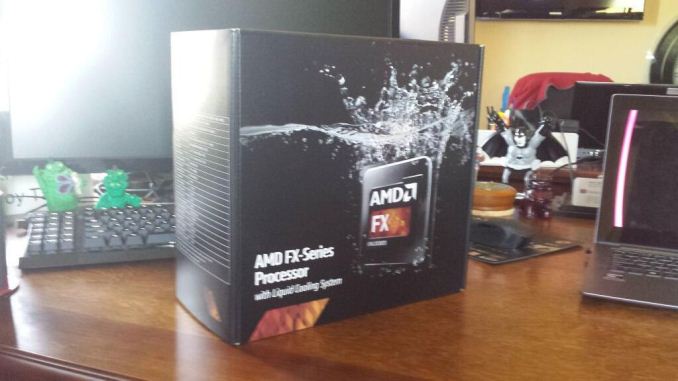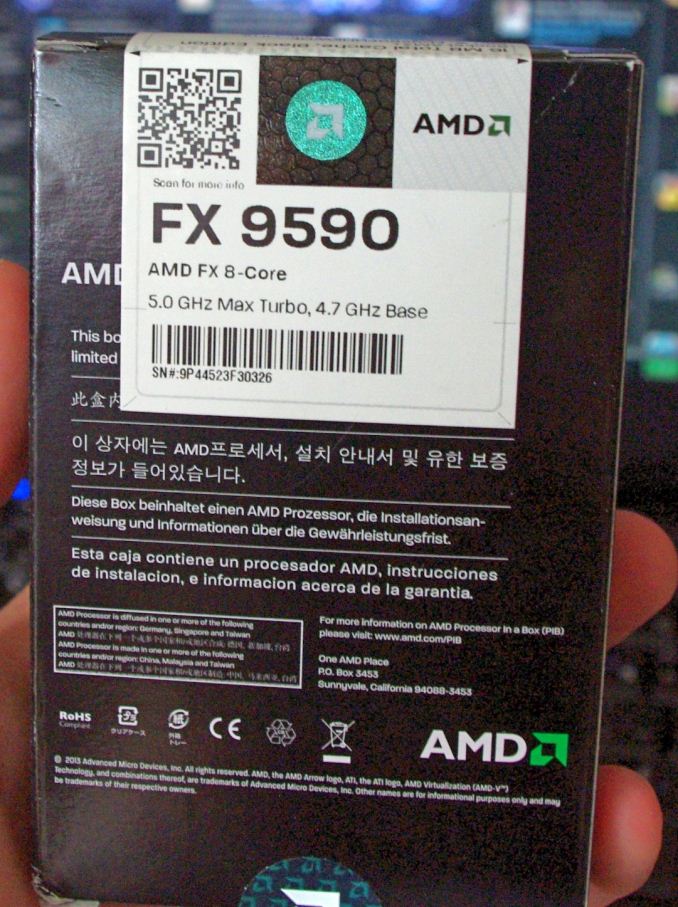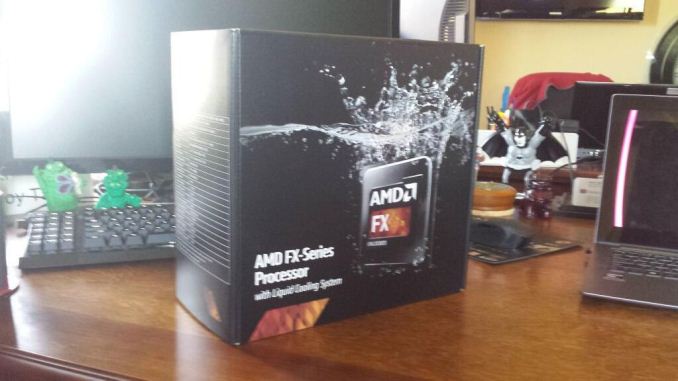AMD’s 5 GHz Turbo CPU in Retail: The FX-9590 and ASRock 990FX Extreme9 Review
by Ian Cutress on August 9, 2014 8:00 AM EST
While AMD’s FX-9590 CPU has been in systems for over a year, it suddenly comes to market as a retail package for end-users to buy with a bundled liquid cooling system. This 220W CPU that has a turbo speed of 5.0 GHz still sits at the top of AMD’s performance stack, despite subsequent improvements in the architecture since. We have decided to grab ASRock’s 990FX Extreme9 and an FX-9590 for a review to see if it still is the AMD performance CPU champion.
Spot the CPU
The story behind AMD’s fastest ever x86 CPUs is slightly odd. Two models, the FX-9590 and FX-9370, were both launched into OEM channels in June 2013. Being an OEM component, the only way to get one was in a pre-built system through a retailer, or through a bulk system integrator that had a model around one of these CPUs. Typically this is a process that is only exhibited with server class processors: from a range of CPUs being produced, only several will be available for end-users at retail because server CPUs usually go through a system builder. At the time, it seemed that AMD concerned that the high TDP of this CPU, at 220W listed, is too much for most cooling setups within a home user system and the best way to get it to consumers would be if a system builder chose the appropriate cooling for them.
As a result of this orientation of sales, AMD did not sample the media with review units. We review an AMD product typically though an AMD sourced sample. It was also noted that the OEM price for the CPU was near $900 for the FX-9590, which seemed like an excruciating amount for what was essentially a good overclocking version of the FX-8350. Several media websites were able to collaborate with system builders in order to get a chance to review the CPU, and AMD was confident in their promotion and handling of the new CPU.
Anecdotally, in my field of vision, the promotion of this CPU was relatively limited. The price was the main factor, resulting in comparative AMD/Intel systems being more power hungry on the AMD side, and substantially more expensive when put up against the latest mainstream i7 at the time. As a result, while some retailers were selling the OEM CPU at full price, some retailers decided to sell their OEM stock with a severe price cut directly to consumers, down from $900 to $390, in order to get rid of units (this is when I picked up our sample).
Due to the OEM nature of these sales to end-users, each CPU had either no warranty with AMD or a limited warranty. For the user interested in a 3-year system cycle without the fear of a bad egg, the OEM route is never a positive one.
AMD subsequently released, relatively silently, a proper package and retail version of the FX processors. It was apparent that this was in response to the OEM sales, with the retailers list ‘heatsink and fan not included’ alongside the specifications.
| AMD FX CPU Comparison | ||||||
|
FX- 4350 |
FX- 6350 |
FX- 8320 |
FX- 8350 |
FX- 9370 |
FX- 9590 |
|
| Release Date |
April 2013 |
October 2012 | October 2012 | October 2012 | June 2013 | June 2013 |
| Modules | 2 | 3 | 4 | |||
| L1 Cache (Code) | 128 KB | 192 KB | 256 KB | |||
| L1 Cache (Data) | 64 KB | 96 KB | 128 KB | |||
| L2 Cache | 4 MB | 6 MB | 8 MB | |||
| L3 Cache | 8 MB | |||||
| TDP | 125W | 220 W | ||||
| Base Frequency | 4200 | 3900 | 3500 | 4000 | 4400 | 4700 |
| Turbo Frequency | 4300 | 4200 | 4000 | 4200 | 4700 | 5000 |
| Core Name | Vishera | |||||
| Microarchitecture | Piledriver | |||||
| Socket | AM3+ | |||||
| Memory Support | DDR3-1866 | |||||
| Price (US) | $140 | $140 | $160 | $190 |
$230 $300 CLC |
$300 $370 CLC |
Since that release, AMD has not upgraded their enthusiast processor line with the latest architecture. The FX line has stayed where it is, perhaps for a number of reasons. One could speculate that releasing the next generation of FX-85xx might put them behind the FX-9590 in performance, or that the fabrication process was not suitable for a quad-module CPU with the new architecture improvements. The FX line for desktops, as far as we know, is staying at 32nm with no improvements.
Now Available
Fast forward twelve months to June 20th 2014 and Roy Taylor, AMD’s VP of Global Channel Sales tweets this innocuous picture:
Speculation was rife as to what this was. Here is a large box for an FX processor with the words ‘with Liquid Cooling System’ underneath. AMD supplied liquid cooling to the media when we reviewed the FX-8350 CPUs, the main CPU that sits underneath the FX-9590 and FX-9370, so there was an expectation that was something new.
On June 26th, the @AMDFX twitter account posted the following, confirming that this was the older FX-9590 but in a retail box with retail cooling:
To celebrate the start of ‘Round of 16’, we’re giving away eleven FX-9590 CPUs! #FXCUP pic.twitter.com/21JRaHdMq8 — AMD FX (@AMDFX) June 26, 2014
The AMD FX Processor page has been updated accordingly, showing the same render of the new box. Here we see that the liquid cooler is supplied by Cooler Master, and uses a wide range PWM fan as part of the package.
Of course, this leaves several questions unanswered: how much, when is it on sale, where is it on sale, and is it still any good? Well for the US at least, it is on sale today from Newegg at $370 with the water cooling kit, or $330 without. NCIX has it listed for CAD$500, although this is currently in ‘back stock’ mode.
The SKU to look for is the FD9590FHHKWOX, which in the UK does not seem to be on the shelves as of yet. Amusingly, when this is typed in to Google, the search engine asked me if I meant FD9590FHHKWOF, the non-CLC version.
This Review
Back when the FX-9590 was originally released alongside the FX-9370, we were unable to secure a sample from AMD and the limited availability made us feel the CPU had a fairly limited scope for testing. However, now the landscape has changed. There has been no new FX CPUs on the market from AMD, and this subsequent release of a retail version piques the interest as to how relevant AMD still sees their high-frequency part. Because I now have a FX-9590 all of my own to test from when the OEM stock was sold, I felt it was worth revisiting to see if it can be considered an investment.
Alongside testing this CPU, the 220W TDP requires a substantial motherboard to match. Due to the age of the platform, the AM3+ socket and the old 990FX chipset, finding a motherboard can be rather tricky. Many of the AM3+ motherboards that were launched were only suited for the FX-8350 processors, which had a 125W TDP. This is yet another reason that AMD wanted the FX-9590 in the hands of system builders who would chose high end motherboards that could cope.
Two of the newest motherboards to be released for 990FX were the ASRock 990FX Killer and the ASRock 990FX Extreme9. We reported the release of the Killer in December 2013, but the Killer is unsuitable here as the specification sheet lists processors up to 125W only. The Extreme9 is ASRock’s high-end AM3+ motherboard, and more suited to the task. Luckily I had requested a sample almost a year ago for some regression testing, so we will be reviewing this motherboard as part of this article.














146 Comments
View All Comments
Budburnicus - Wednesday, January 14, 2015 - link
Umm, it is QUITE possible to get a SandyBridge to 5 GHz, in fact I have my i7-2600K rock stable at 4.7 GHz (where my Haswell i7-5930k is 4.4) - and it TOTALLY SPANKS this POS FX 9590! Less power, same clock speed, MUCH higher performance!AT is being TOO EASY on AMD, not too harsh! This CPU is not a "win" in any sense!
bebimbap - Saturday, August 9, 2014 - link
No matter what any one that loves this FX-9590 says, this processor is just an exercise in gluttony, and devolution.I have been spoiled by computer evolution. coming from the commodore/Macintosh/SX286 days. you appreciate a few things. such as noise/heat/size reduction of modern systems.
50-80w cpus are quiet, compared to the pentium4 days.... or Hairdryer days...
SSDs are silent,
modern HDDs are basically silent, compared to 40MB drives and 3.5/5.25 floppies and don't forget the stack of floppies you had in the drawer instead of a single USB stick.
modern gpus not oc'd are quiet, still remember the hiss of my gforce3Ti
CRTs - actually have a noise when you turn them on, some buzz when in use... and don't forget the size.
case- you either had a monster of a case that would break your table if you put it on it, or a fugly thing that you wanted to hide under the table.
overall the heat produced compared to a 19" crt + pentium4/thoroughbred + 9800XT compared to a modern system also let you get rid of the window AC unit reducing a lot of noise.
so i am spoiled because i can now have a system where i'm not sweating like a pig and going deaf while playing my favorite game or browsing the web. I don't need a 1000w speaker system to hear the gunshots clearly over my cpu/gpu/psu fans or window AC unit.
I no longer need a computer be a 4in1 device that acts as a heater, a LOUD white noise generator, an air filter, and computer. It should be similar to a BMW-M5, everyday comfort and driveability but grunt when you want it, but of course with better fuel economy.
Leyawiin - Saturday, August 9, 2014 - link
This article makes me feel good about the FX-6300 @ 4.5 Ghz I have. At least with the games they chose to benchmark I'm doing fine.siberus - Saturday, August 9, 2014 - link
Any chance we could get some testing with radeon gpu's using mantle ? :) would be pretty neat to see how some of the older/lower tiered cpu's break down. Unless you guys have done something like that already in another article then I apologize for asking.monstercameron - Saturday, August 9, 2014 - link
this cpu just chew through integer workloads, faster than a 4770k, where it fails is every thing else. I reckon a well optimized program written directly[fma?] for it would haul ass!resination - Saturday, August 9, 2014 - link
This is THE processor for the "rolling coal" set.CSammy - Saturday, August 9, 2014 - link
Pathetic. The cover might as well be Intel pissing on this AMD processor, because that is quite literally the truth in nearly every single aspect.TiGr1982 - Saturday, August 9, 2014 - link
Note that there is no recent Devil's Canyon Core i7-4790K here - this one, being around 13% faster than i7-4770K in CPU-bound tasks, would make the FX to look even less relevant.TheinsanegamerN - Saturday, August 9, 2014 - link
"AMD clearly does care about the performance market"yeah, thats why they couldnt even be bothered to use the new kaveri cores, instead rehashing an old piledriver cpu with higher clocks and a TDP that puts netburst to shame. all the while, performing sligtly slower then a intel cpu with a third the tdp and running 1.5 GHz slower.
They care about the performance market so much, that they put this chip on the 3 year old AM3+ platform, rather than the new FM2+ platform, just so we can use old chipsets with feature sets from 2011.
And it costs as much as a core i7.
CLEARLY, AMD still cares about the performance market.
TiGr1982 - Saturday, August 9, 2014 - link
I perfectly understand your sarcasm :)I guess, it was something like that: AMD did not and does not have the resources and/or desire to invest into pure many-module CPUs beyond Piledriver FX CPU. So, from the engineering standpoint, they stopped there.
But then the marketing stepped in and said: "We need a faster CPU to brag. Because we aren't developing a new one, can you boost the current one?" And the engineering team said "Yes... Okay...". And they did. :)